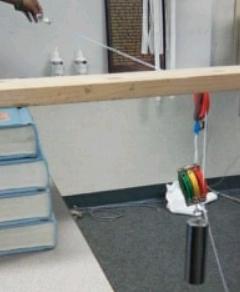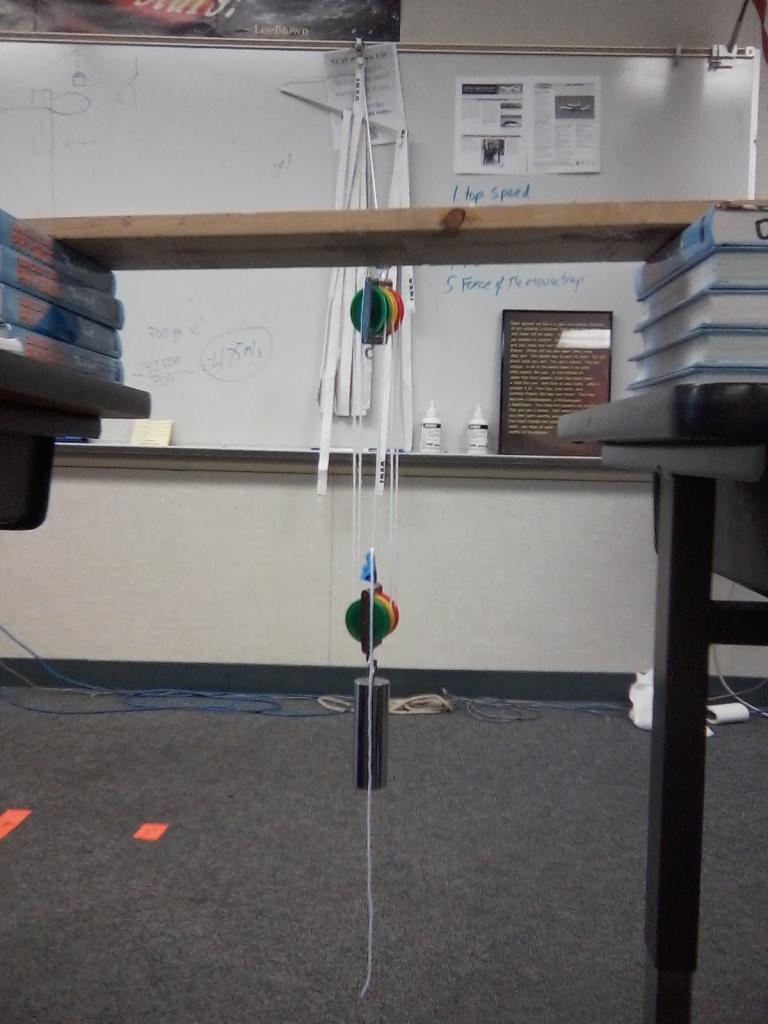
Purpuse: To measure the work i joules of different amounts of pulleys
Procedure: 1. Place a board on two equal size piles of books on two adjacent tables
2. Make sure the screw- eye sticks out in the middle and is easy to reach
3. Take a 1kg weight
4. Attach your wieght to a string
5. Place the weight on the floor and run the string up over the pulley attached to the screw eye
6. Tie the other end of the string to a Newton scale
7. Pull the scale so that the weight is lifted off the floor
8. Read the newton scaleboth for mass (grams) and weight (Newtons)
9. Continue the pull until the weight reaches the height of the lab station
Data:
|
|
Mass |
Hieght Of Lab Station |
Mass on Scale |
Force on Scale |
Distance Of String pulled |
Work |
|
1 pulley |
1 kg |
.78 m |
1 kg |
10 N |
.72m |
7.2J |
|
2 pulleys |
1 kg |
.78 m |
.7 kg |
7 N |
1.37m |
9.59J |
|
3 pulleys |
1 kg |
,78 m |
.5 kg |
5 N |
2.17m |
10.85J |
|
4 pulleys |
1 kg |
.78 m |
.35 kg |
3.5 N |
2.84m |
9.94J |
|
5 pulleys |
1 kg |
.78 m |
.3 kg |
3 N |
3.43m |
10.29J |
|
6 pulleys |
1kg |
.78 m |
.25 kg |
2.5 N |
4m |
10J |
Observation : In the data i collected i observed that as the number of pulleys increased the less force was needed to lift the weight. I observed that even if the the forec did change the work was an averge og 10 joules. I analysied that the mass also decreased as the number of pulleys increased.
Conclusion: In conclusion noticed that the work always stayed roughly the same. In averge the work was always 10 joules with 1 pulley to 6 pulley. This is because work will always stay the same. No matter how many pul
leys you have you will always have the same work. This is because the pulleys distribute the work evenly between you and the numbers of pulleys. For example lets say you have a box and you are pushing then your friend comes along and helps you. The box feels easier to push but not because it got lighter but because the work was distributed evenly between your friend and yourself. The same amount of work is thier but you only get a fraction of it. This is the same case with the pulleys
Final Key Points: 1. The more forxe their is the less string required
2. Every time a pulley is added it lowers the Newtons about 1.5
3. Pulleys do not decrease the work needed they just distribute it evenly



